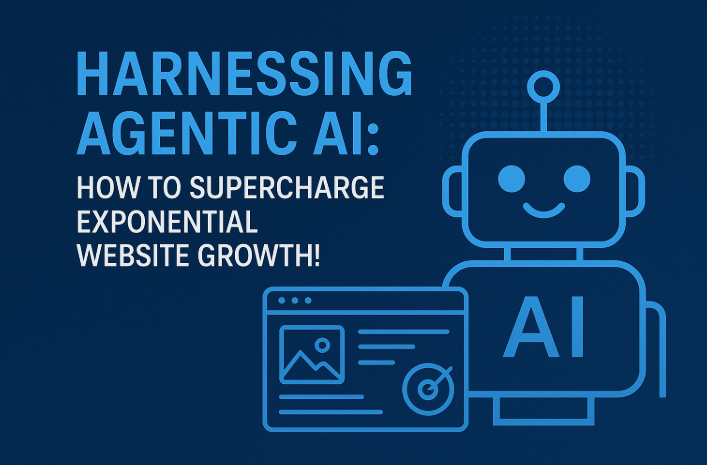
As artificial intelligence evolves, a new class of intelligent systems is quietly reshaping how websites operate: Agentic AI. Unlike traditional AI that needs constant prompts and supervision, agentic AI acts with intention, adapting autonomously to achieve defined goals. For businesses running online platforms or eCommerce websites, this is more than a trend—it’s a game changer.
In this post, we’ll break down what Agentic AI is, why it matters, and how it can revolutionize your website operations—from SEO and content creation to customer support and conversions.
What Is Agentic AI?
Agentic AI refers to artificial intelligence systems that demonstrate autonomy, goal-setting, planning, and adaptation. These are not just reactive tools like chatbots—they are intelligent agents capable of making decisions and acting on them with minimal human input.
A 2023 OpenAI research paper defines these systems as “AI agents that can plan, monitor progress, interact with tools, and revise their approach based on outcomes” (OpenAI).
This agentic behavior contrasts sharply with typical AI use cases like content generators or search assistants. Where those models respond to prompts, agentic AI takes initiative: identifying problems, testing solutions, and adjusting strategies—all in real time.
Why Agentic AI Is a Game-Changer for Websites
Until recently, most AI in web environments was passive. It might recommend content, respond to queries, or optimize images—but always under human direction.
Now, agentic AI can:
- Crawl your site and identify weak content
- Rewrite outdated pages without being asked
- Adjust SEO tactics based on traffic drops
- Test CTA placements and adjust based on click-through rates
Essentially, agentic AI acts like a team of digital strategists working 24/7—without burnout, meetings, or guesswork.
5 Real-World Uses of Agentic AI on Your Website
1. Personalized On-Site Experiences in Real Time
Agentic AI observes how users interact with your site and responds immediately. For example, if a visitor spends time on pricing pages but doesn’t convert, the AI might:
- Adjust CTA copy dynamically
- Surface a chatbot offering help
- Show a time-sensitive discount based on behavior
According to McKinsey, companies using advanced personalization see a 5–15% lift in revenue and up to 30% improvement in marketing efficiency (source).
2. Autonomous Content Creation and Management
Tools like AutoGPT allow AI to generate blog posts, revise product pages, and even plan internal linking—all without direct human prompts. Combined with tools like AgentOps, websites can keep content fresh, optimized, and search-ready at scale.
This is ideal for:
- eCommerce product descriptions
- SEO landing pages
- Blog content marketing
3. Self-Improving SEO Systems
Agentic AI isn’t just a writing assistant—it’s a strategist. It can:
- Identify which blog posts are underperforming
- Test and optimize title tags and meta descriptions
- Adjust content structure based on search trends
Platforms like Content at Scale and Surfer SEO are starting to integrate these capabilities into AI-powered publishing systems. Instead of hiring an entire SEO team, agentic AI can optimize in real time.
4. Customer Support That Actually Solves Problems
While most chatbots follow scripts, agentic AI can act with discretion:
- Issue refunds
- Escalate when necessary
- Follow up proactively via email
According to Gartner, 25% of customer service operations are expected to use AI agents by 2027 to handle complex interactions and even decision-making tasks—something basic bots cannot do.
5. Automated Conversion Optimization
Agentic agents monitor traffic flows, analyze drop-off points, and run micro experiments—changing button placement, form fields, or even entire page structures—based on data.
For example, a tool like Mutiny already allows for AI-powered page experiments, but when paired with agentic logic, it can:
- Run A/B tests autonomously
- Track real-time conversion changes
- Shift traffic toward top-performing funnels without human input
This eliminates the need for constant A/B testing cycles or manual CRO oversight.
How to Start Using Agentic AI on Your Site
You don’t need a data science team to get started. Many modern no-code and low-code tools now enable agentic workflows on websites. A few paths:
- Zapier with OpenAI: Build trigger-based automations with embedded LLM logic (source)
- OpenAI Assistants API: Deploy custom agents to automate tasks like support, content, or research
- ContentOracle AI: Agentic content management and internal search optimization for WordPress
The key is to start with one part of your site that’s high-impact but time-consuming—like updating product content or triaging support requests—and build from there.
The Future of Agentic AI and Websites
Agentic AI represents a major leap forward in digital operations. Rather than rely on human teams to prompt and manage tools, businesses can begin delegating entire categories of work—SEO, content creation, conversion tracking, personalization, and even A/B testing—to autonomous agents that learn and improve over time.
With user experience and dynamic engagement becoming more critical in Google’s ranking algorithms (E-E-A-T guidance), sites that adapt in real time will increasingly outrank those that don’t.
Final Thoughts
Agentic AI isn’t just another tech trend—it’s a foundational shift in how websites can think, act, and grow.
Whether you’re a startup founder looking to scale with limited staff or a marketing team trying to improve ROI, integrating agentic AI into your website infrastructure will give you a serious edge in 2025 and beyond.
Start small. Automate one task. Let the AI run. Then scale what works.